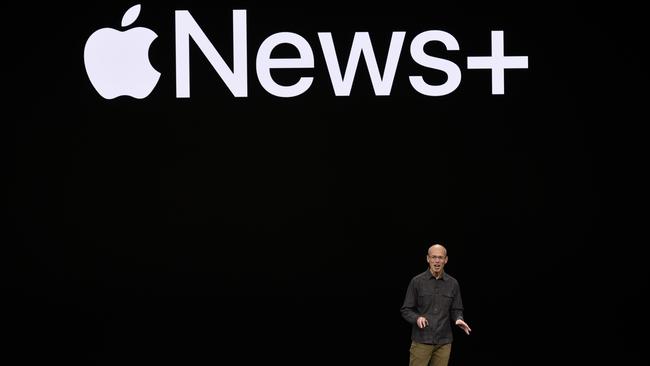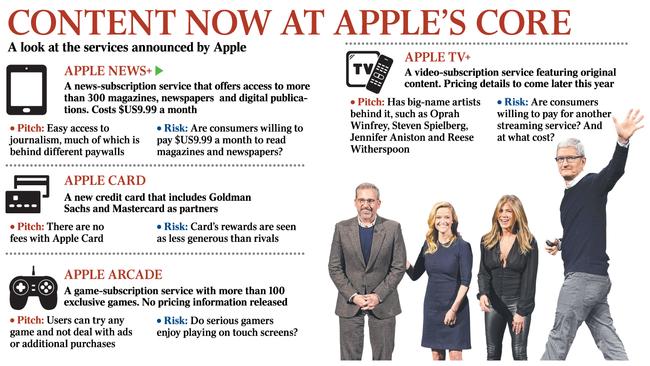Apple enters the digital newsroom
The Google and Facebook business model is in for a monumental shock.

Apple has opened the lid on a brand new kit of services in its bid to overcome the inertia in the smartphone market.
Its new iPhones might come with all the bells and whistles but they are not selling all that well, and for Apple subscription services are a valuable hedge in a tough market.
Whether it’s games, movies, television or news, Apple is now banking on the billion-plus devices it has in the market globally to sell subscriptions.
Apple’s new strategic direction is built on the volume of devices in the market. This is the infrastructure through which Apple hopes to become the ultimate middleman.
World’s gatekeeper
The Apple News+ service, which we know for certain is coming to Australia, offers a glimpse of Apple’s thinking.
Apple has signed a deal with The Wall Street Journal to deliver news through its devices. The global reach and reputation of the US newspaper gives Apple a big boost in signing up more national newspapers over time.
The service could become the essential gatekeeper to the publishing world, offering traditional publishers a better say in how their content is delivered to the public. It’s also an alternative that allows publishers access to a much bigger audience without undermining the paywall model that has finally found its feet.

The curation comes at a hefty price: Apple will reportedly keep 50 per cent of subscription revenue. But for many publications, including WSJ, Apple’s service offers an alternative to the tyranny of Google and Facebook’s opaque algorithms and will add valuable eyeballs, particularly from tech-savvy millennials.
As Robert Thomson, chief executive of News Corp, ultimate owner of the WSJ and The Australian, wrote in a letter to employees yesterday: “For too long, media companies have been hobbled by dominant platforms’ algorithmic ambiguity and their disregard for funding models that truly support quality journalism.”
Apple’s decision to charge for news goes some way towards righting the wrongs of the 1990s and early 2000s, when media companies collectively put all their content online for free. That industry misfire was then exacerbated by the flagrant negligence of the tech giants, which in some cases allows users to bypass publication paywalls and use algorithms instead of human editors to decide what is newsworthy.
Paying for journalism
Apple is stepping up in a way that many news companies, even in this country, are not, by putting a dollar value on news. Nine titles The Age and The Sydney Morning Herald have soft paywalls that can be bypassed by users with just a small amount of knowhow.
That decision leaves Nine in no-man’s land, offering up every article on those websites for free, until the user decides to either pay after five articles or to open a private browsing tab.
The Guardian, too, despite positioning itself as a global journalism leader, still refuses to charge for its work, instead asking for readers to contribute donations. A keen Guardian reader could, if they chose, read the publication’s entire body of work for free.
Apple is doing what Google, Facebook, The Guardian and to a degree Nine have yet to do, and that’s to set a hard paywall and declare that the journalism behind it is worth the money.
By taking a partnership approach and working hand in hand with publishers, Apple has an opportunity to slowly change the behaviour of the media consuming public, and make it comfortable again with the notion of paying for quality journalism.
Apple has proved in the past decade that consumers can be happy to throw money at things other than iPhones, iPads or Macbooks. Its “services” revenue, which includes the App Store, the Mac App Store, Apple Music, Apple Pay and AppleCare, is the fastest growing arm of its business.
During the first fiscal quarter of this year, Apple’s services segment raked in $US10.9 billion ($15.3bn) in revenue globally, up from the $US9.1bn the unit earned in the first quarter of last year. Most newspapers will surely be keen to take a slice of that pie.
More than 1.8 billion Apple Pay transactions were made during the first quarter of this year — two times more than the previous quarter — and Apple News, the free version of the app, set a new record of more than 85 million monthly active users.
Apple has more than 360 million paid subscribers for its services globally, an increase of 120 million from one year ago. Its chief financial officer Luca Maestri said on a recent earnings call that the company expects the total number of paid subscribers to surpass half a billion next year.
Giving credit
That’s half a billion people already paying Apple for things other than hardware. The 500,000,000 subscribers bolster the tech giant’s aspirations as a financial services player through the launch yesterday of its credit card.
Apple’s not looking to directly challenge the traditional financial services industry but it gives the company better visibility on consumer spending and credit financing. It gets the visibility without being embroiled in regulation: Mastercard and Goldman Sachs will be taking care of that.
Its credit card not only allows Apple to offer a single channel through which consumers can manage all of their subscriptions but also offers a rewards program — a 2 per cent cash back every time a customer pays with the Apple Card and 2 per cent cash back every time a customer buys something directly from Apple.
It’s unlikely to help Apple move more iPhones in a hurry but it’s a channel that could pay off in the long term.
Oliver Kidd, founder of Melbourne-based fintech company Archa, says Apple deserves credit for its ecosystem of products and services that keep consumers in its world.
“By launching Apple Card, Apple has signalled an intent to play a more active role in that crucial customer journey,” Kidd tells The Australian. “Rather than a move to topple the banks, I think it’s a clever play into a market where non-financial companies were traditionally excluded.
“There’s no reason why other players can’t join the party.
“A better customer experience that is entirely digital is what both us and Apple are trying to achieve. Considering the tired state of financial products in Australia, there is obviously a huge opportunity here for fintechs or challenger banks to truly innovate the customer experience.”
The tech giant has a target of reaching $US14bn in services revenue per quarter by next year and its strides across news and also finance, gaming and TV mean it’s well on its way to achieving that.
Apple is aiming to become a kingmaker in not only news but also TV, where it has a dozen original shows in the works.
Tech giants grow
Its tactics are to ape other tech giants: Amazon is entering adjacent fields like cloud computing, original TV and film production and financial services.
Google parent company Alphabet, meanwhile, has announced a foray into subscription gaming, and has its fingers in many pies, including fibre broadband, advertising, and self-driving cars. The test will be just how long these services stick around, given how distant they sometimes are from the tech giants’ core capabilities.
Apple is good at running services: iTunes and the App Store have been very successful for the company and its Apple Music subscription has been a hit despite Apple being late to the market.
The challenge for Apple is contestability, because for every one of its new services there are a number of established players already in the market.
From Netflix to Amazon to Google, Apple will face serious competition. But it does have a secret weapon: privacy.
Apple was at pains to point out yesterday that it won’t collect the personal data of its customers.
Given the scrutiny on the nefarious practices of its big-tech peers, Apple’s privacy play might gain traction.
Where the likes of Google and Facebook thrive on collecting customer data, Apple says its revenue is going to come from subscription revenue from its customers, rather than from on-selling their data to third parties.
As the tech world continues to shift from selling phones and tablets to instead selling news and content, Apple’s foray may be a sign that big tech, in true partnership with publishers, could help bolster a struggling industry that was once decimated by tech.
And if Apple’s past successes are anything to go by, a new golden era of journalism might be on the horizon.


